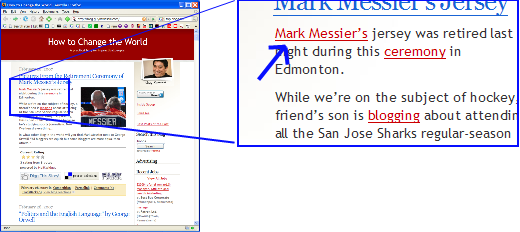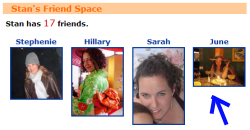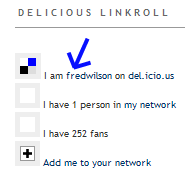Of the key insights of Google was to realize that links were not just pointers or bookmarks: they also implicitly convey an endorsement, a “vote” for the pointed-to entity.
With the advent of blogging and social networking sites, there seem to be 3 distinct flavors of links emerging. New generations of link analysis tools must be aware of these flavors in order to fully understand what information is being conveyed by the linkmakers. Lots of people seem to be talking around this and even building tools to manage it (Ziki, Wink, etc…) but I haven’t seen anyone spell it out, so here’s my shot at it.
1) The Pointer Link
This is the link we all think of, the link that was envisioned back when they were called “hyperlinks”. It’s basically a citation, like an footnote from an academic journal.
English translation: I examined the exact content I am now pointing to, and I found it to be worthwhile. It’s worthwhile to go there.

A normal pointer link in a blog post.
2) The Subscribe/Friend/Trust Link
These links are the hallmarks of RSS and social networks. These links are not endorsements of the exact content pointed to, but of the author or creative source represented by the link.
English translation: I often examine content that comes from this source, and I find it to be worthwhile. Further content from this source is probably also worthwhile.
Note that this type of link talks not only about past content from the author, but is also a prediction that future content will also be worthwhile. (As Seth once said about subscriptions, it’s a promissory note for attention that will be paid in the future.)

Blogroll on Guy Kawasaki’s blog

My friends on MySpace
3) Identity Link
These links are maybe the newest to grow in importance. With the proliferation of content creating platforms, it’s becoming more difficult to tie your online identity together. People must now create “identity indexes” that list who they are on different services.
English translation: “I create the content at this source, and take full responsibility for it.”

Guy Kawasaki identity-linking to his page on LinkedIn

Fred Wilson identity-linking to his del.icio.us profile
Anti-Links
If I had to bet, I’d say the next important step in linking will be anti-links. In the real world, you also often recommend against things and clarify who you are not. For example:
- “Did you hear that Mary is now into multilevel marketing?”
- “Scrubs used to be funny, but now it sucks.”
- “My name is Michael Bolton. … No, not the singer.”
There are only a few parallels to this in the online world.
- rel=”nofollow” : This microformat in a link indicates that the author does not endorse what is pointed to. It was developed to solve the problems of links in blog comments. If a commented leaves a link, the author of the blog does not want to endorse whatever the commenter linked to. (Okay, not really an anti-link, more of an un-link.)
- rev=”vote-against” : This microformat in a link indicates that the author activly recommends against what is pointed to. It is not really supported, however. (Except by Lijit!)
The most widely used anti-links come things like the anti-phishing features of Firefox and IE, the “dangerous” sites of SiteAdvisor , or the ad-blocking lists like Filterset G. (Why do we allow anyone with a web page to create positive links that contribute to (for example) PageRank, but we leave the job of anti-links to “professionals”?)
As more people get online and more and more web services are created, there are bound to be more username collisions. For example, this bfeld is certainly not this bfeld, and this stan is not this stan!
Conclusion
Google changed the world by realizing and exploiting the extra semantic information in those newfangled “hyper links”. I think successful companies of the future will learn to read a new generation of links that are even more meaning-laden that their forbears.
Of course I hope Lijit is one of those companies. 🙂 We’re certainly on the right track.


The graphical shorthand we use expressing these relations and to work out complicated situations:

NIce grafix